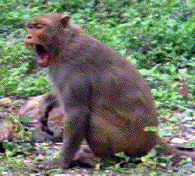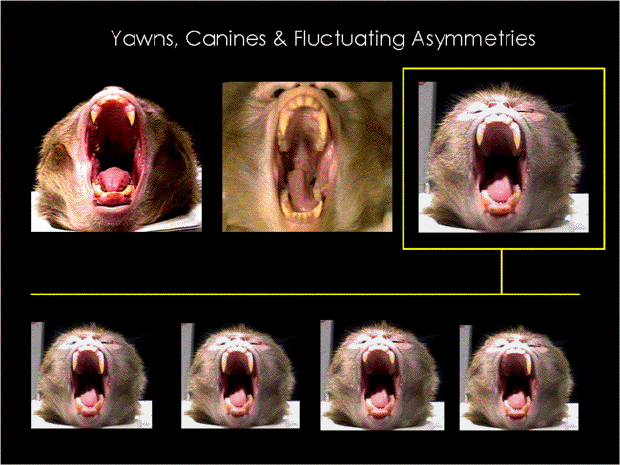The sex difference in yawning does not
appear until after males are fully
post-pubertal, increasing at puberty when
testosterone levels are rising (Hadidian, 1980;
Troisi et al., 1990). During experiments testing
hormonal effects on sexual behavior, it was
noted that in fully adult males, castration
almost completely eliminates male yawning
(Phoenix et al., 1973). The administration of
testosterone replacement to castrated males
restores yawning rates to those comparable to
that seen in intact males (Phoenix et al.,
1973). Further, this increase in castrated males
occurs in a dose-dependent fashion (Phoenix and
Chambers, 1986). Data such as these led Phoenix
(1976) to state "yawning is one of the most
reliable behavioral indicators of injected
testosterone and dihydrotestosterone ... an
increase in male sexual behavior is always
accompanied by an increase in yawning and vice
versa."
Female rhesus monkeys rarely, if ever, yawn.
However, administration of exogenous androgens,
either testosterone or the nonaromatizable
androgen, dihydrotestosterone (DHT), can induce
yawning in adult females (Goy and Resko, 1972;
Johnson and Phoenix, 1976; Wallen and Goy,
1977). Taken together, these findings suggest
that in adult macaques, yawning is a behavior
which both males and females are capable of
displaying that is strongly regulated by
androgens.
More recently, the link between male yawning
and androgens has been tested using androgen
receptor blockers. Deputte and colleagues (1994)
investigated the effects of hydroxyflutamide,
the active metabolite of flutamide, on yawning
in adult male rhesus monkeys. This study found
that hydroxyflutamide injections were as
effective as the withdrawal of testosterone in
reducing the rates of yawing whether
testosterone was given at physiological or
supraphysiological levels. Interestingly, under
both testosterone conditions, flutamide
injections took longer to have an effect than
did androgen withdrawal. The present study
tested whether the nonsteroidal anti-androgen
flutamide was capable of blocking the behavioral
effects of exogenous androgen administration in
female rhesus monkeys. If the behavioral effects
of flutamide in females parallel that seen in
males, it would support the notion that yawning
is under similar control in both sexes and that
the sex difference in yawning reflects
differences in circulating androgens and not
differences in the organization of male and
female brains.
(....) 
Discussion
This study replicates and extends previous
work with androgens and yawning in rhesus
monkeys. Rates of yawning were very low during
the baseline period, consistent with previous
data from 20 h of observations in this setting
(Graves et al., 2002). DHT, a nonaromatizable
androgen, significantly increased rates of
yawning in adult females as was seen in Wallen
and Goy (1977). Flutamide blocked this effect,
reducing the rate of yawning in females treated
with both DHT and flutamide concomitantly.
Deputte and colleagues (1994) observed a return
of yawn rates to baseline levels with
hydroxyflutamide in males, unlike the present
flutamide treatment in females, which did not
return yawn levels completely to baseline.
However, in the Deputte study a longer period of
anti-androgen was given and yawning rates did
not return to baseline until the end of this
extended treatment, suggesting that with
extended treatment yawning rates may have
returned completely to baseline levels. The
results of this study extend the work of Deputte
and colleagues (1994), indicating that
behavioral effects of androgens in females, as
in males, are reversible with an androgen
receptor blocker.
Flutamide has received wide use as a
nonsteroidal antiandrogen for the treatment of
hormonally dependent prostatic cancer. However,
it has not been clear whether flutamide is as
active centrally as it is peripherally (cf.
Gray, 1977). The present findings, as well as
those of Deputte and colleagues (1994), show
that rates of yawning, a centrally mediated
behavior, are reduced by flutamide. These data
suggest that in both males and females flutamide
crosses the blood brain barrier and is capable
of exerting influence on central structures
through interactions with androgen receptors.
Whether central concentrations are as high as
those produced peripherally cannot be resolved
from our data.
Following castration, adult male rhesus
monkeys show a marked decline in yawning as well
as sexual behavior (Phoenix et al., 1973). Since
flutamide effectively reduces yawning in adult
males (Deputte et al., 1994), one would expect
to see a similar decline in sexual behavior.
Although this has not been investigated in
males, there has been one study of the effect of
flutamide on female sexual behavior.
Administration of flutamide to cycling females
in pair tests did not alter their sexual
behavior, unlike its effect on yawning in the
present study (Johnson and Phoenix, 1978),
suggesting that female sexual behavior is not
androgen mediated as some have suggested (e.g.,
Baum et al., 1977). In conclusion, flutamide
appears to be an effective tool for blocking the
central effects of androgens in rhesus monkey
females. Yawning provides a simple behavioral
endpoint for assessing central androgenic
activity. The similarity of the behavioral
effects of flutamide in males and females more
strongly supports the hypothesis that yawning is
controlled by similar brain mechanisms in both
sexes and that the sex difference in yawning
reflects differences in circulating androgens
and not differences in the organization of male
and female brains.
References
Baum, M.J., Everitt, B.J., Herbert, J.,
Keveme, E.B., 1977. Hormonal basis of
proceptivity and receptivity in female primates.
Arch. Sex. Behav. 6 (3), 173-192.
Darwin,
C., 1872. The Expression of the Emotions in Man
and Animals. John Murray, London.
Deputte,
B.L., 1994. Ethological study of yawning in
primates: I. Quantitative analysis and study of
causation in two species of Old World monkeys
(Gerocebus albigena and Macaca fascicularis).
Ethology 98, 221-245.
Deputte,
B.L., Johnson, J., Hempel, M., Scheffler, G.,
1994. Behavioral effects of an antiandrogen in
adult male rhesus macaques (Macaca mulatta).
Horm. Behav. 28 (2), 155-164.
Goy, R.W., Resko, J.A., 1972. Gonadal
hormones and behavior of normal and
pseudohermaphroditic nonhuman female primates.
Recent Frog. Horm. Res. 28, 707-733.
Graves, F.C., Wallen, K., Maestripieri, D.,
2002. Opioids and attachment in rhesus macaque
(Macaca mulatta) abusive mothers. Behav.
Neurosci. 116 (3), 489-493.
Gray, GD., 1977. Differential effects of the
antiandrogen flutamide on aspects of sexual
behavior in castrated, androgen-treated male
rats. Psychoneuroendocrinology 2 (4),
315-320.
Hadidian, J., 1980. Yawning in an Old World
monkey, Macaca nigra (primates:
cercopithecidae). Behaviour 75, 134-147.
Johnson, D.F., Phoenix, C.H., 1976. Hormonal
control of female sexual attractiveness,
proceptivity, and receptivity in rhesus monkeys.
J. Comp. Physiol. Psychol. 90 (5), 473-483.
Johnson, D.F., Phoenix, C.H., 1978. Sexual
behavior and hormone levels during the menstrual
cycles of rhesus monkeys. Horm. Behav. Il (2),
160-174.
Phoenix, C.H., 1976. Sexual behavior of
castrated male rhesus monkeys treated with
19-hydroxytestosterone. Physiol. Behav. 16 (3),
305-310.
Phoenix, C.H., Chambers, K.C., 1986. Aging
and primate male sexual behavior. Proc. Soc.
Exp. Biol. Med. 183 (2), 151-162.
Phoenix, C.H., Slob, AK., Goy, R.W., 1973.
Effects of castration and replacement therapy on
sexual behavior of adult male rhesuses. J. Comp.
Physiol. Psychol. 84 (3), 472-481.
Michael, R.P., Zumpe, D., Bonsall, R.W.,
1986. Comparison of the effects of testosterone
and dihydrotestosterone on the behavior of male
cynomolgus monkeys (tvfacaca fascicularis).
Physiol. Behav. 36, 349-355.
Troisi,
A., Aureli, F., Schino, G., Rinaldi, F., De
Andelis, N., 1990. The influence of age, sex,
and rank on yawning behavior in two species of
macaques (Macacafascicularis and Mfuscata).
Ethology 86, 303-3 10.
Wallen, K., Goy, R.W., 1977. Effects of
estradiol benzoate, estrone, and propionates of
testosterone or dihydrotestosterone on sexual
and related behaviors of ovariectomized rhesus
monkeys. Horn. Behav. 9 (3),
228-248.



